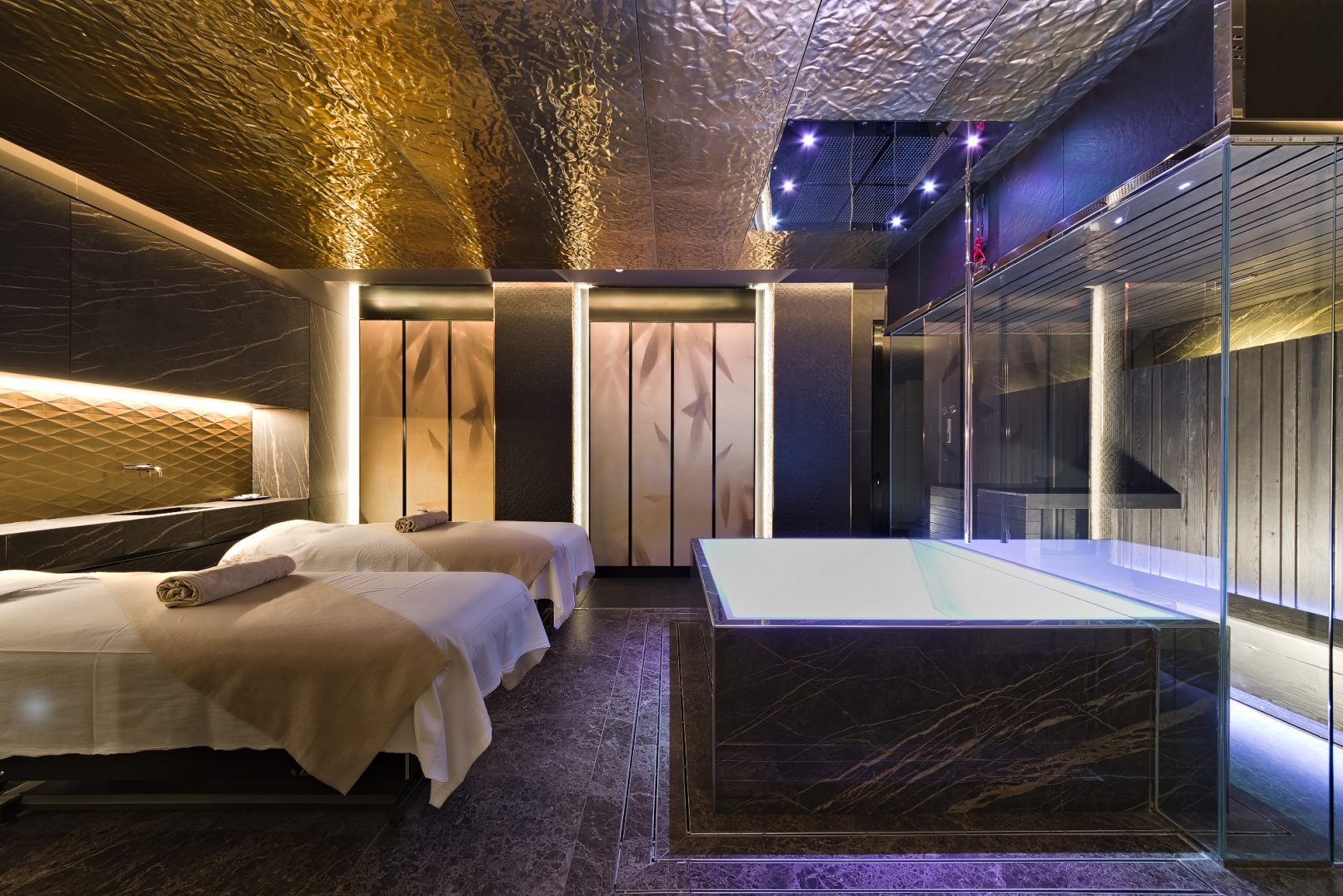The wellness world has its own etiquette, unspoken rules that can make or break your relaxation experience. From the wrong attire to awkward bodily mishaps, understanding proper spa etiquette matters more than you might think. Wellness is good, right? It must be—better than unwellness, anyway. But what actually is wellness and how do you do it properly? Is it sitting in a field and trying to be really good at breathing while someone bangs a gong? Or is it doing yoga on a Cornish beach and mindfully trying to pick chia seeds out of your teeth with your tongue? Or could it be, fingers crossed, sitting in a beer garden and being at one with a packet of pork scratchings? After spending decades trying to be less unwell and countless hours in spas around the world, from budget massage spots in Thailand to luxury wellness retreats, there are definitely some hard-learned lessons worth sharing about navigating the sometimes confusing world of spa treatments and wellness etiquette.
1. Dress the Part: The Spa Clothing Conundrum
The issue of clothing at wellness places causes anxiety for many first-time visitors, and even veterans sometimes get it wrong. Early experiences shape our spa comfort levels forever.
The Thai Massage Incident
A formative massage experience in 1990s Thailand while living in Hat Yai, a city near the Malaysian border, provides a cautionary tale. At the cheap local massage spot you would change into some light, loose fisherman’s trousers, then be led into a room to join half a dozen other clients.
Picture this: lying face down on a mat, a nice old lady kneeling behind you, gently pulling your arms back to stretch your core. As your torso lifts from the floor, you realize that your fisherman’s pants are swiftly unraveling and there’s nothing you can do to stop it. This kind of wardrobe malfunction creates lasting spa anxiety.
The Paper Pants Problem
Not that things are much better at the fancier spas that have become more accessible since then. Who came up with the idea of wearing paper pants for a massage? Seriously. It’s embarrassing enough trudging from your hotel room to the spa wearing a fluffy robe without knowing that all you’ve got on underneath is essentially a hat from a Christmas cracker.
Many spa-goers have bought into this nonsense for far too long. The resolution? Simply keep your regular underwear on at all times. Most professional spa therapists accommodate this preference without issue, and it eliminates the anxiety of disposable undergarments.
What to Actually Wear to a Spa
For those seeking practical guidance on spa attire, here’s what works:
Swimming areas: Bring your own swimsuit rather than relying on spa-provided options. Luxury spas often provide robes and slippers, but having your preferred swimwear ensures comfort.
Treatment rooms: Comfortable underwear you don’t mind getting slightly oily from massage treatments. Dark colors hide any massage oil stains better than light fabrics.
Relaxation areas: That fluffy robe they provide is actually perfect. Embrace it. Just ensure it’s properly tied before wandering corridors.
Fitness facilities: Proper workout gear if you’re using spa fitness centers. Don’t attempt yoga in your paper pants.
2. Chill Out, Dude: The Waiting Game
If you are wearing paper pants, the last thing you want to do is hang around. However, go to a spa, any spa, and that’s exactly what you’ll be doing. This might be the most universally frustrating aspect of spa experiences.
The Pre-Treatment Wait
If you’ve booked a massage for 2:30pm, that’s when you want the show to begin. That’s when you want the first bone to be cracked. You don’t want to spend the first ten minutes pacing around an overheated “relaxation room“, ignoring the cucumber water and waiting for your therapist to collect you.
And you don’t want to spend the last ten minutes back in the same room—which is now somehow freezing cold—drinking nettle tea and reading magazine articles about celebrity kitchen renovations.
The Privacy Pause
The worst, though, the absolute worst, is when the therapist steps out of the room to allow you some privacy to take off your robe and lie on the bed. You don’t need to leave! The paper pants situation has already eliminated dignity! It’s more infuriating than the wait between receiving the bill in a restaurant and the waiter deigning to bring over the card machine.
Once at a spa in the Bahamas, after being left alone so long, the temptation arose to storm into the corridor to see where the therapist had disappeared to. Boy, was that a mistake. Learning the hard way that if there’s one thing worse than a disappearing masseuse, it’s an angry one. Ouch.
The Solution
The key is to arrive for the treatment already relaxed. Maybe that requires a massage before your massage—or at least accepting that spa time operates on a different clock than normal life. Build buffer time into your schedule and genuinely use those relaxation rooms for their intended purpose rather than anxiously watching the clock.
3. Natural Disasters: Handling Awkward Bodily Functions
We’ve all been in situations where we’ve had to… hold it in. Massages can last a long time and if you realize early on that trouble is brewing, it’s not as if you can just let rip. Or can you?
The Digestive Dilemma
The therapist has probably seen, and heard, it all before. Professional spa therapists undergo training that prepares them for every bodily function imaginable. They’re not judging you—they’re focused on providing therapeutic benefit.
Whatever you do, don’t abruptly climb off the massage table, dash into the corridor, fail to find the loo and end up just sort of hobbling around, smiling at the reception staff and waiting for the storm to subside. If you need a bathroom break, simply communicate it. Say “I need to use the restroom” and the therapist will graciously step out.
The Arousal Issue
And talking of wanting things to subside, what about when, ahem, “man things” happen? The passing of a bus can prompt unrest, so the likelihood of it happening when somebody is rubbing jojoba oil into your upper thigh is pretty high.
A quick jog round the garden isn’t really an option, so how exactly does one quell the uprising? The spa music is for exactly this purpose. Tune in to those libido-deadening chimes and gongs and peace will be swiftly restored. Focus intensely on your breathing, mentally recite multiplication tables, or visualize yourself explaining spa etiquette to your grandmother—anything to redirect blood flow to your brain.
Additional Spa Etiquette Tips
Communication is Key
Spa therapists appreciate communication. Too much pressure? Say so. Too little? Speak up. Uncomfortable temperature? They can adjust it. The best massage experience comes from open dialogue between client and therapist.
Tipping Protocols
Tipping at spas varies by location. In the United States, 15-20% is standard for spa treatments. In Europe, tipping is less expected but appreciated. At luxury wellness retreats, check if gratuity is included in treatment pricing.
Arriving Early
Despite frustrations with waiting, arriving 15-30 minutes early for spa appointments is proper spa etiquette. This allows time for check-in paperwork, changing into spa attire, and actually using that relaxation room to transition into a peaceful mindset.
Phone-Free Zones
Spas are sacred phone-free spaces. Turn devices to silent (or better yet, leave them in your locker). Nobody wants to hear your ringtone during savasana, and you’re defeating the purpose of wellness if you’re scrolling Instagram between treatments.
Shower Before Treatments
Most spas provide showers for pre-treatment use. Taking a quick rinse before your massage is courteous to your therapist and enhances your own experience. It removes the day’s grime and helps you relax.
Alcohol Consumption
Drinking before spa treatments impairs the therapeutic benefits and creates safety issues. Save the champagne for after your massage, when you can actually appreciate it while relaxed rather than dehydrated.
Understanding Different Spa Cultures
Asian Spa Traditions
Spas in Thailand, Japan, Bali, and other Asian destinations often have different etiquette than Western establishments. Communal bathing is common, nudity policies vary, and treatment styles differ. Research cultural expectations before visiting international spas.
European Wellness Culture
European spas and thermal baths typically embrace nudity more than American counterparts. German spas, for instance, often require nude use of sauna facilities. Wellness retreats in Switzerland and Austria may have textile-free zones.
American Spa Standards
United States spas generally prioritize privacy and modesty. Those paper pants are standard issue, and you’ll rarely encounter mandatory nudity. Luxury spas in major cities maintain strict professionalism.
Types of Spa Experiences
Day Spas
Day spas offer treatments without overnight accommodation. They’re perfect for locals seeking regular wellness maintenance or tourists adding pampering to their travels. Expect massage, facials, body treatments, and sometimes salon services.
Destination Spas
Destination wellness retreats provide immersive wellness programs lasting multiple days or weeks. These include spa treatments, fitness classes, nutritional guidance, and holistic programming. Examples include Canyon Ranch, Miraval, and SHA Wellness Clinic.
Hotel Spas
Luxury hotel spas serve hotel guests and outside visitors. They range from modest treatment rooms to elaborate facilities with thermal pools, relaxation areas, multiple treatment rooms, and full fitness centers.
Medical Spas
Medical spas (med spas) offer clinical treatments under medical supervision alongside traditional spa services. These might include injectables, laser treatments, and other procedures beyond standard massage therapy.
The Benefits of Proper Spa Etiquette
Understanding spa etiquette enhances your wellness experience exponentially. When you’re not worried about what to wear or how long to wait, you can actually relax and receive the therapeutic benefits that spa treatments provide.
Proper spa etiquette also shows respect for therapists, other guests, and the wellness space itself. Spas cultivate peaceful environments where people seek respite from daily stress. Following etiquette maintains that sanctuary atmosphere for everyone.
When Things Go Wrong
Even with perfect spa etiquette, mishaps happen. Maybe the massage oil triggers an allergic reaction. Perhaps the relaxation room temperature makes you dizzy. Or that cucumber water wasn’t sitting well.
Professional spas handle these situations gracefully. Communicate problems immediately so staff can address them. Most luxury spas will comp treatments if they failed to meet standards or reschedule if you felt unwell.
Finding Your Spa Style
Not everyone thrives in traditional spa environments. Some people find relaxation rooms boring, prefer deep tissue massage to gentle Swedish strokes, or would rather skip the nettle tea entirely.
The beauty of the modern wellness world is diversity. Boutique spas offer unique experiences, wellness retreats cater to specific interests, and even budget massage spots provide professional treatments. Finding spa experiences that match your preferences makes wellness feel authentic rather than performative.
Whether you’re doing yoga on beaches, breathing mindfully to gong sounds, or yes, achieving wellness through beer gardens and pork scratchings (mindfully, of course), the point is finding what actually makes you feel well.
The spa etiquette described here—from resolving the paper pants problem to handling natural bodily functions gracefully—simply helps you navigate wellness spaces more confidently. Armed with this knowledge, your next massage experience might actually be relaxing rather than anxiety-inducing.
Explore more wellness travel insights, spa destination guides, and mindful living resources at The Inspiring Insight—where we believe true wellness comes from finding what actually makes you feel good, paper pants optional.


